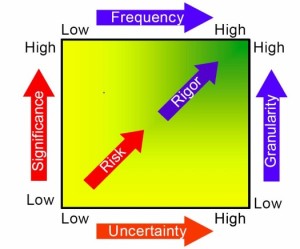Traditional views tend to favor a management approach built on the assumption that more detail is better – and to a point, this is undoubtedly correct. Insufficient detail in a plan of any type is a sure way to fail; ‘just do it’ at the overall project level does not help. But, finessing project plans to present useful information at the right level of detail is not easy – decisions have to be made!
Balancing the factors shown in this diagram helps make the right decision. As the risk environment increases, the project controls need to be more rigorous. The risk environment is influenced by the size or significance of the identified risks, and the overall degree of uncertainty associated with the work. As either (or both) of these factors increase, the controls systems need to be more rigorous.
The two factors that influence the degree of rigour in the controls system are the amount of detail included (granularity) and the frequency of the monitoring, reviewing and updating of the plans. But, as suggested above, too much detail will increase costs and reduce efficiency and effectiveness.
There’s no right answer to this paradox, our latest article The Planning Paradox – How much detail is too much? offers some useful guidelines to consider (download the article).
For more on Schedule Strategy, Planning, & Design, see: https://mosaicprojects.com.au/PMKI-SCH-011.php



Always an interesting topic, Pat…
Speaking as both a CONTRACTOR as well as an OWNER, on projects where our own money is on the line, our overall guiding principle is that “God (or the devil if you prefer) lies in the details.” (Ludwig van der Rohe)
Therefore, when in any doubt, “more” (detail) is preferable to “less.”
Having said that, the three “COMPETENT Leaders” we look to are:
Field Marshal Helmuth von Moltke (the Elder) who told us “no plan survives first contact with the enemy,” a fundamental truth that was reiterated by General Dwight Eisenhower, who said in 1951 that “Plans are useless, but planning is essential.” This is why w believe most “planners and schedulers,” few of whom have any field experience and are little more than “computer jockeys,” are little more than contractual obligations, whose primary function is “after the fact” is claims analysis.
Because of the TRUTHS from von Moltke & Eisenhower, we pay little or no attention to the CPM schedule hanging on the wall or to the critical path. We are firm believers in “rolling wave planning” (Sprints or Scrums for our Agilists), which brings us to General Omar Bradley, who told us, “Amateurs study STRATEGY while professionals study LOGISTICS.” Especially as CONTRACTORS, as we live and die by our CASH FLOWS that take precedence over the critical path, and the way we keep the project on time and within budget is by efficiently managing our RESOURCES.
As both OWNERS and CONTRACTORS, we are absolute FANATICAL ADVOCATES supporting the use of Earned Value Management. (EVM). But NOT as the US government or PMI or AACE teach it, but EVM as it evolved on the factory floors of 18th Century Industrial Rvolution, as a “Pay for Performance” or “Incentive Payment System” as Gillett and Dana explain in their 1909 book “Cost Keeping and Management Engineering: A Treatise for Engineers, Contractors, and Superintendents Engaged in the Management of Engineering Construction.” https://books.google.co.id/books?redir_esc=y&id=zO-ADudj-R8C&focus That is how CONTRACTORS have been using EVM for hundreds if not thousands of years, and how many of us continue to use it today. (“Unit in Place” cost estimating, unit pricing, and billing)
As our focus is on CASH FLOW and keeping our crews working EFFICIENTLY, using EVM, we pay relatively little attention to TOTAL FLOAT. Our focus is on maintaining “cash flow neutrality” (cash in = cash out) and on keeping our SPI and CPI between 0.95 and 1.05. The only time we look seriously at Float is to keep our TF between the ED and LD Curves and to compare TF and SPI to balance or reallocate our workforce.
For anyone interested in seeing this entire process explained step-by-step, you can go here https://build-project-management-competency.com/1-4-1-11-unit-11/ Figures 42 to 65.
After 50 years in business cash is king….. But you also need log term viability.
At least in construction, we have long had what we call the “20/20 rule”- At ~20% Gross Profit Margin you will win about 20% of the projects you bid.” Funny but in ~50 years, it has not changed? The total $$$ values of the projects keep going up but NOT the margins!!!
Go HERE https://build-project-management-competency.com/1-4-1-3-unit-3/ and see Figures #40, 41, and #42.
I keep urging my students to create one for IT and other sectors but so far, no takers. (My gut feel HYPOTHESIS is they won’t be all that much different?)
The “long-term viability” comes from aggressively protecting those single-digit bottom line margins. (See Figure #41?) (10%/2 = 5%. Hence the SPI/CPI targets between 0.95 to 1.05)
You should be so lucky – the Australian construction industry profit margins (competitive tenders) have been 2% to 4% for the last 20+ years. This is one of the reasons innovation is so slow.